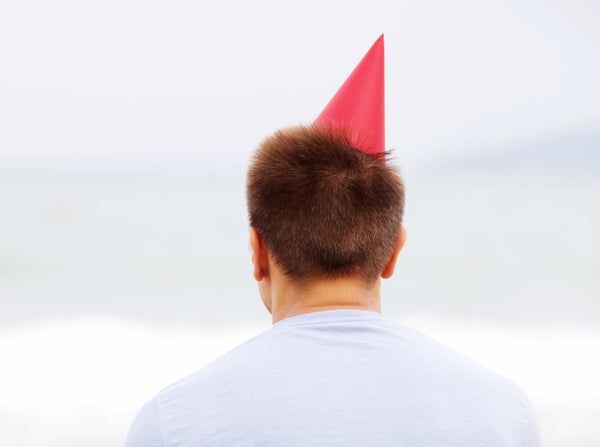Imagine living a life without the ability to relish the delectable sweetness of ice cream, the joy of getting together with an old friend or a small triumph at work. People who suffer from a condition called anhedonia find it hard to enjoy much of anything. They are not necessarily sad, but feel very little pleasure in daily existence—or none at all. Finding the motivation to socialize, take action in the world and access life’s rewards is painfully elusive for them.
Anhedonia is a common symptom of depression and one of the so-called “negative symptoms” of schizophrenia (as opposed to “positive” ones such as delusions), but it is not present in all patients with these illnesses. It also afflicts some people with bipolar disorder, substance abuse and Parkinson’s disease as well as an unknown number of individuals with no other diagnosed brain disorder.
The biology of anhedonia is not well understood, although it has been linked to abnormal volume in brain structures related to seeking rewards and, according to brain scans, less activity in these areas. Anhedonia is also associated with a poor prognosis, including heightened risk of suicidal thoughts.
On supporting science journalism
If you're enjoying this article, consider supporting our award-winning journalism by subscribing. By purchasing a subscription you are helping to ensure the future of impactful stories about the discoveries and ideas shaping our world today.
The condition is difficult to treat successfully. Drugs commonly used for depression such as selective serotonin reuptake inhibitors (SSRIs) can help relieve hopelessness and other negative feelings but they do not necessarily promote positive feelings or joy.
Fortunately for sufferers, dozens of studies looking at anhedonia are currently underway or have recently been completed. Several involve drug treatments, ranging from a dietary supplement to a form of amphetamine to experimental medications. In addition, some clinicians report preliminary evidence showing the anesthetic ketamine might be useful in treating anhedonia.
Psychiatry professors Moria Smoski of Duke University Medical Center and Gabriel Dichter of the University of North Carolina at Chapel Hill School of Medicine are co-leading one of the first clinical trials targeting this condition with customized talk therapy. They have begun recruiting 210 patients to be part of a five-year randomized trial. Half will receive an experimental therapy that is a tweaked version of a common treatment for depression called behavioral activation therapy, which involves giving patients very concrete tasks and goals that reflect the patients’ values. The other half will be placed in a control group that will learn mindfulness techniques.
Patients getting the experimental therapy might, for example, be told to attend a certain number of parties or gatherings each week, even if that seems unappealing. Or they might have a goal of making dinner for a friend who just got out of the hospital. The theory behind this approach, the researchers say, is that if you take part in such activities and find they were somewhat enjoyable, then it will fuel a positive feedback cycle in the brain. Eventually the patient will want to go to these events unprompted—and even look forward to them. “The overarching goal is to do things that have a chance of feeling important, enjoyable or both. These activities are intended to feed on themselves,” Smoski says. “For example, by being a supportive friend, their friendships become deeper, more rewarding, and it feels easier over time to set and keep those goals.”
“We know that people with anhedonia don’t look forward to things other people might find enjoyable, and unless they put themselves in the position to try something they won’t have the opportunity to enjoy it,” says Erika Forbes, a professor of psychiatry at the University of Pittsburgh who researches anhedonia but is not involved with this trial. “This is ‘fake it until it becomes real’—and that can happen,” she says.
The core idea of prompting patients to take external actions is what psychologists call “activation”—it is a key component of all behavioral activation interventions. The anhedonia-specific trial adds two new pieces that are not considered standard, Smoski says. “One is what we are calling dabbling—each week trying one new thing that is a short-term commitment, just to try it. The other is practice in savoring—noticing what you like about an activity using your five senses or noticing a sense of pride or enjoyment in an accomplishment.”
Targeting anhedonia directly, as opposed to treating overall depression, is a relatively new idea that is attracting increasing attention. Michelle Craske at the University of California, Los Angeles, is working on a behavioral intervention called positive affect treatment. Like the Smoski–Dichter work, it aims to beef up the brain’s sensitivity to rewards but it has a greater focus on asking patients to recount recent enjoyable events in order to emphasize and reinforce pleasure. Forbes, meanwhile, is running her own multiyear study tracking teens who are at high risk of developing anhedonia to see how the condition develops during adolescence and whether it presages worse long-term outcomes in that population, as some research suggests. “Anhedonia is a symptom that is really hard to move around from a clinical perspective, so finding out what may underlie it is really savvy,” says Randy Auerbach, a professor of psychiatry at Columbia University who is not part of these studies.
And because it is “a really debilitating condition” that affects such a wide range of patients well beyond those with depression, Forbes points out, the payoff of a successful treatment could be enormous.
